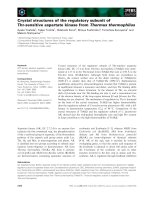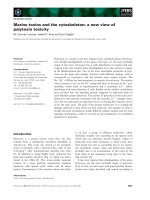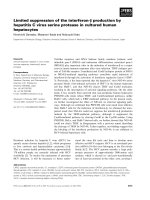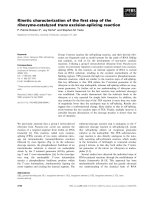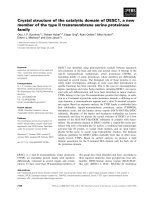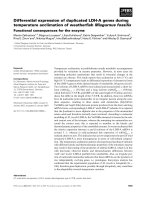báo cáo khoa học: "Inflammatory pseudo-tumor of the liver: a rare pathological entity" potx
Bạn đang xem bản rút gọn của tài liệu. Xem và tải ngay bản đầy đủ của tài liệu tại đây (245.5 KB, 5 trang )
REVIE W Open Access
Inflammatory pseudo-tumor of the liver:
a rare pathological entity
Walid Faraj
*
, Hana Ajouz, Deborah Mukherji, Gerald Kealy, Ali Shamseddine, Mohamed Khalife
Abstract
Inflammatory pseudo-tumor (IPT) of the liver is a rare benign neoplasm and is often mistaken as a malignant
entity. Few cases have been reported in the literature and the precise etiology of inflammatory pseudotumor
remains unknown. Patients usually present with fever, abdominal pain and jaundice. The proliferation of spindled
myofibroblast cells mixed with variable amounts of reactive inflammatory cells is characteristics of IPT. We reviewed
the literature regarding possible etiology for IPT with a possible suggested etiology.
Introduction
Inflammatory pseudo-tumor (IPT) of the liver i s a rare
benign neoplasm and is often mistaken as a malignant
entity. They were first described in the lung in 1939 and
have been reported subsequently in nume rous locations,
including the liver, spleen, lymph nodes, spinal cord,
salivary glands, breast, and soft tissues. Liver involve-
ment was first described in 1953 by Pack and Baker and
may lead to biliary obstruction, portal hypertension, cir-
rhosis, and eventually hepatic failure. Few cases have
been reported in the literature with no recognized etiol-
ogy for IPT [1-4]. Patients usually present with fever,
abdominal pain and jaundice. The proliferation of
spindled myofibroblast cells mixed with variable
amounts of reactive inflammatory cells is characteristic
of IPT. IPT is sometimes misdiagnosed as a malignant
tumor based on radiographic findings. We reviewed the
literature regarding poss ible etiology for IPT with a pos-
sible suggested etiology.
Exaggerated Inflammatory response
Inflammatory pseudotumour (IPT) of the liver, also
known as inflammatory myofibroblastic tumor is a rare
benign condition, which has been diagnosed with
increasing frequency because of recent advances in ima-
ging techniques. It is associated with many disease enti-
ties including Crohn’s disease [5], diabetes mellitus [6],
Sjögren’s syndrome [7], gout [8], chronic ascending cho-
langitis, primary sclerosing cholangitis [9], Kostmann’s
disease [10], acute myeloblastic leukemia [11], HIV
[12,13] and autoimmune pancreatitis [14,15]. Possible
etiologies that would cause such an exagge rated inflam-
matory response include the possibilities of an unidenti-
fied infectious agent, autoimmune phenomena and
systemic inflammatory response syndrome.
Several mechanistic etiologies have been proposed
which includes increased biliary concentration of mono-
meric bile acids. This biochemical aberration can lead to
bile duct injury and pericholangitis followed by onion
skin type periductal fibrosis and finally chronic scleros-
ing cholangitis. This was mechanism has been eluci-
dated and strengthened by three different and separate
experimental models: 1) feeding lithocholic acid (LCA)
(a monomeric bile acid) to mice [16] 2) common bile
duct ligation which consequently lead to increased
monomeric bile acid in bile ducts [17,18] and3) Mdr2/
Mrd3 gene (gene responsible for canalicular phospholi-
pid lipase) knock out mice [19] which results in an
increased biliary concentration of monomeric bile acids
in the absence of biliary phospholipid secretion and its
equivalent in humans. All three of these experimental
mouse models will result in inflammation of the biliary
ducts of the mouse.
The assumed pathophysiology resulting from litho-
cholic acid toxicity in the liver was described by Fickert
et al. He suggested that lithocholic acid leads to altera-
tions of tight junctions of biliary epithelial cells resulting
in leaky bile ducts and chemotaxis of neutrophil granu-
locytes. This is followed by inflammatory reaction and
extravasation of toxic bile which lead to subepithelial
fluid accumulation, and concomitant detachment of the
* Correspondence:
Department of Surgery, HPB and liver transplantation unit, American
University of Beirut Medical Center, Beirut, Lebanon
Faraj et al. World Journal of Surgical Oncology 2011, 9:5
/>WORLD JOURNAL OF
SURGICAL ONCOLOGY
© 2011 Faraj et al; licensee BioMed Central Ltd. This is an Open Access article distributed under the terms of the Creative Commons
Attribution License (http://creativecom mons .org/licenses/by/2.0), which permits unrestricted use, distribution, and reproduction in
any medium, provided the original work is properly cited.
biliary epithelium resulting in lifting of the epithelial cell
layer. After which, neutrophil granulocytes invade the
bile duct lamina via transmigration and ulcerations of
the epithelial cell layer. Then the ongoing efflux of toxic
bile into the portal field; together with activation of bili-
ary epithelial cells, leads to proliferation and activation
of periductal myofibroblast s resulting in rapidly evolving
periductal fibrosis.
IPT relationship with other pathologies
IPT and sclerosing cholangitis
Patients with thickened bile ducts and stricture forma-
tion and dilation of the duct distal proximal to that
point. Many of the cases were not initially diagnosed as
having sclerosing cholangitis [9].
IPT and Crohn’s disease
The pathology showed stricture in the common bile
duct (CBD) and dilated intrahepatic ducts. There is
some evidence of biliary stricture disease consistent with
and similar to primary sclerosing cholangitis. In addi-
tion, some patients h ave atypical biliary duct epithelial
cells which could be caused by intraductal LCA crystals
that damage BEC s (biliary endothelial cells) as the result
of the hydrophobic and lithogen ic physicochemi cal
properties of LCA [5,16] (knowing that LCA crystals
could only be seen by electron microscopy).
IPT and autoimmune pancreatitis
Swelling of the pancreatic head could have lead to dis-
ruption in the flow of bile and therefore increase con-
centration of monomeric acid, which lead to bile duct
hyperplasia, and formation of IPT. The pathology was
reversed with steroids [15,16].
IPT and gastrointestinal stromal tumor (GIST) of the ileum
The presence of an ileal GIST could potentially disrupt
bile acid absorption and the obstruction in the tumor
could cause increased concentration of bile acid. Simi lar
pathologic changes occur in-patient with ulcerative
colitis in which large amounts of lithocholic acid is
absorbed and presented to a susceptible liver [17,18,20].
IPT with recurrent pyogenic cholangitis
Hanada et al correlated the finding of hypoattenuating
areas of IPT on CT scans with chronic inflammatory
infiltrates with foamy histiocytes, plasma cells and
lymphocytes on pathology. Iso-attenuating and hyper-
attenuating areas were correlated with fibroblastic prolif-
eration. In all the reported cases, intrahepatic ducts were
irregularly dilated and diffusely thickened. In addition,
periductal white fibrosis was noted and the hepatic
ducts contained da rk brown to black muddy fragile
stones in all such patients. The question was whether
IPT could be caused by bile stasis, while recurrent
inflammation and calculi provoke degeneration and
necrosis of the bile duct wall with subsequent periductal
abscess or formation of xanthogranulomas (as in
the case of xanthogranulomatous cholecystitis). An
important conclusion of these studies was that IPT
could develop as one of the spectra of recurrent pyo-
genic cholangitis [21-25].
Tight junction alterations of the biliary duct epithelium
Sakai et al [26] reported that IPT was shown to enhance
by extravasation of contrast material in fibrous tis sue on
delayed-phase CT (3 to 6 minutes after injection of con-
trast material) where as no characteristic enhancement
pattern is seen on the early phase (40 to 100 seconds).
Early enhancement of CT scans has been reported to be
related to vascularity, whereas delayed uptake may
be caused by slow diffusion into the abnormally large
extracellular space of the hepatic mass. This delayed
enhancement suggests that there is disruption in the
tight junctions of the biliary duct epithelium in IPT
which might also be explained by LCA toxicity that
leads t o tight junction alterations preceding lifting and
ulceration of the epithelial cell layer in the bile duct.
Tight junction alterations may be of primary importance
in LCA-induced cholangiopathy [17]. Tight junctions
between hepatocytes also showed alteration s of the ZO-
1 pattern with distortion and widening indicative of
dilated canaliculi resulting in leaky bile ducts and che-
motaxis of neutrophil granulocytes and extravasation of
toxic bile. In cases where obstruction or raised pressure
in the biliary system is present, these lesions might
result from rupture of the canals of Hering [27] with
exposure of hepatocytes to bile acid concentrations in
the millimolar range derived from bile leaking into the
liver parenchyma [28].
Idiopathic inflammatory strictures of extrahepatic biliary
tree
Idiopathic benign inflammatory strictures of extrahepa-
tic bile ducts and IPT may share a common etiology.
Several patients with IPT have developed e osinophilia,
which may serve to detoxify LCA in the periductal tis-
sues. Kafeel et al [29] reported that IPT was regarded as
an abnormal exuberant tissue response to some external
stimulus [30] or pathology s imilar to retroperi toneal
fibrosis [31]. While the mechanism leading to this con-
dition remains unclear, extravasation of bile into the
gallbladder wall, with involvement of Rokitansky-Aschoff
sinuses, or extravasation through a small ulceration in
the mucosa, appears to be a precipitating factor.
Inborn errors of bile acid metabolism
In the rare cases of inborn errors of bile acid metabo-
lism one of the prominent clinical features is liver and
spleen enlargement, and the progression of the liver dis -
ease is most rapid when the defect results in accumula-
tion of bile acids [32-34]. The liver disease may be
Faraj et al. World Journal of Surgical Oncology 2011, 9:5
/>Page 2 of 5
trans ient, delayed in onset and mild. Pathologic findings
in this disease include intralobular cholestasis with giant
cell transformation, prevalence of necrotic hepatocytes
including giant cell forms, a nd hepatic injury confined
to the portal limiting plate where the smallest bile duc-
tules may be injured, resulting in neocholangiolar prolif-
eration. G iant cell transformation was thought to be the
result of fusion of hepatocytes whenever toxic bile acids
are present, similar pathology is seen in IPT.
Elevated bile acid concentration
Increased bile acid concentration has been observed in
many other entities. One of which is MDR3 deficiency,
which is thought to lead to decreased excretion of cy to-
protective biliary phospholipids, leaving an increased
pool of cytotoxic biliary bile salts that gives rise to sub-
sequent bile duct damage and proliferation and release
of gamma glutamyl transpeptidase (GGTP) into the
serum [35-40]. This was also noted in biliary atresia
resulting in inflammatory and fi brous cells surro unding
miniscule ducts, bile duct proliferation, severe cholesta-
sis with plugging, and inflammatory cell infiltration [41].
Some authors suggested that all bile acids, at concen-
trations >25 μmol/L; induce a 2.5- t o 3-fold increase in
hepatic stellate cell proliferation via activation of the
epidermal growth factor receptor. Bile acid-induced pro-
liferation is mediated by activation of a protein kinase
C/extracellular signal-regulated kinase/p70
S6K
-dependent
pathway [42]. Bile acid does not only affect the liver, but
exposure of airway epithelium to bile acids may induc e
a fibrotic response. Aspiration of bile acids may induce
airway fibrosis through the production of TGF-b
1
and
fibroblast proliferation [43].
Lithocholic acid and ITP
Lithocholic acid is a hydrophobic secondary bile acid
that is primar ily formed in the intestine by the bacterial
7a-dehydroxylation of chenodeoxycholic acid. It is
poorly water-soluble and rather toxic to cells. In
humans the harmful effects of LCA and other bile acids
are attenuated by two hepatic detoxification pathways,
namely hydroxylation and conjugation. These reactions
make the bile acid more hydrophilic and facilitate its
excretion in the feces or urine. It was interesting to find
that lithocholic acid was present in the serum of
patients with jaundice and, in smaller amounts, healthy
adults [44]. In cholestasis, LCA levels increase in the
liver and intestine [45]. The finding of lithocholic acid
in blood is of interest because of its po ssible role in
injuring human liver [44].
Recent studies suggest that LCA induces its own
detoxification by activating nuclear receptors to promote
transcription of genes encoding sulfotransferase. Litho-
cholic acid is a rare example of a toxic endobiotic; a
variety of mechanisms work to detoxify it [46]. One
involves the pregnane X receptor (PXR), a NR that con-
trols hepatic detoxification pathways for harmful bile
acids and several drugs (such a s rifampicin and pheno-
barbitol) which are equivalent in humans to the steroid
and xenobiotic receptor ( SXR) or pregnane-activated
receptor. Once activated by certain toxic secondary bile
acids and other ligands, PXR attenuates bile acid pro-
duction by directly inhibiting CYP7A1 (cholesterol 7a-
hydroxylase, which catalyzes the rate-limiting step in the
conversion of cholesterol t o bile acids in the liver [47]).
Through this receptor, certain steroids exhibit a protec-
tive effect against various types of intoxication. These
“catatoxic” steroids afford protection against harmful
chemicals by accelerating their metabolism. This might
explain the cases of ITP were the pathology was
reversed by steroid.
Pregnenolone and other catatoxic compounds stimu-
late the transcription of the CYP3A subfamily of cyto-
chrome P450 monooxygenases, where they met abolize a
wide variety of xenobiotics and natural compounds
including steroids and bile acids. In 1970, Selye [48]
showed that PCN (pregnenol one 16a-carbonitrile) pre-
vented the LCA-induced hepatoxicity and mortality in
rodents. PXR plays a fundamental role in prot ecting the
body from toxic bile acids. PXR is activated by LCA and
its 3-keto metabolite and coordinat ely regulates genes
involved in the biosynthesis, transport, and metabolism
of LCA. PXR protects the liver against pathophysiologi-
cal levels of LCA [49].
Conjugated and unconjugated bile acids rapidly induce
EGR and FOS gene expression as well as cytoplasmic
mitogen-activat ed protein kinase (MAPK) activation. Of
the bile acids, lithocholic acid appeared to be more
potent than the other equimolar bile acid concentrations.
The more h ydrophobic bile acid, lithocholic acid, may
induce the inflammatory cascade at relatively low concen-
trations because of its memb rane-diffusing properties
[50]. This mitogenic effect has some cell-specificity
because treatment of unrelated 3T3 fibroblasts with high
concentrations of lithocholic acid caused no detectable
MAPK-induced MBP phosphorylation. The myofibroblas-
tic proliferation in ITP might be from a transformed stel-
late cell. In response to stress, hepatic stellate cells
undergo “activation” which connotes a transition from
quiescent vitamin A-rich cells into proliferative, fibro-
genic, and contractile myofibroblast. The major phenoty-
pic changes after activation include proliferation,
contractility, fibrogenesis, matrix degradation, chemotaxis,
retinoid loss, and WBC chemoattraction [51].
In 1960s the effect of bile acid on raising human tem-
perature was discussed in the Journal of Clinical Investi-
gation. Palmer et al found out that LCA is the most
potent of the naturally occurring steroids that produce
Faraj et al. World Journal of Surgical Oncology 2011, 9:5
/>Page 3 of 5
intense fever and inflammation in man. The endogenous
biliary steroid, lithocholic acid, has significant inflamma-
tory and pyrogenic action in man [51]. It was interesting
to find that six m illigrams of lithocholate injected intra-
muscularly or intravenously is sufficient to produce
intense fever and local inflammation in humans which
might explain the high grade fever which present in
patients with IPT.
The immunohistochemistry (IHC) of IPT
The smooth muscle actin (SMA) and vimentin are
usually positive in stellate and s pindle cells, whereas
desmin, CD34, S100 protein, and anaplastic lymphoma
kinase (ALK) are negative [52,53].
It is likely th at many spindle c ells correspond to a ctivated
histiocytes as they coexpress vimentin and macrophage-
associated markers; they are intermingled with vimentin-
positive fibroblasts and variable numbers of vimentin and
actin positive myofibroblasts [54]. Because of the variable
immunophenotypic patterns seen in hepatic IPT, it is pos-
sible that th ey a rise f r om a common m esenchy mal cell that
is capable of differentiating along different pathways. The
majori ty would develop a myofibroblastic phenotype and
be positive for SMA and vimentin [55]. Many SMA-
positive myofibroblastic cells were found in IPT, hence
suggesting an ongoin g fibrous process.
Inflammatory pseudotumor of the liver constitutes a
diagnostic and therapeutic challenge. In the presence of
a solitary liver lesion, with clinical and laboratory fea-
tures suggesting active inflammation, the diagnosis of
inflammatory pseudotumor should be considered.
Proper investigation to exclude malignancy should be
undertaken, resection of the lesion should be considered
when in doubt.
Several t heories have been proposed for the possible
etiol ogy o f inflammatory pseudotumour of the liver. We
think that the significant inflammatory effect of the bili-
ary steroid lithocholic acid is a major contributor in the
formation of those benign lesions in the liver.
Authors’ contributions
WF drafted the manuscript, HA and DM participated in the design of the
study, GK and MK participated in the design and coordination of the study.
All authors read and approved the final manuscript.
Competing interests
The authors declare that they have no competing interests.
Received: 30 July 2010 Accepted: 23 January 2011
Published: 23 January 2011
References
1. Koea JB, Broadhurst GW, Rodgers MS, McCall SL: Inflammatory
pseudotumor of the liver: Demographics, diagnosis and the case for
nonoperative management. J Am Coll Surg 2003, 196:226-235.
2. Copin MC, Gosselin BH, Ribet ME: Plasma cell granuloma of the lung:
difficulties in diagnosis and prognosis. Ann Thorac Surg 1996,
61:1477-1482.
3. Horiuchi R, Uchida T, Kojima T, Shikata T: Inflammatory pseudotumour of
the liver: clinicopathologic study and review of the literature. Cancer
1990, 65:1583-1590.
4. Pack GT, Baker HW: Total right lobectomy. Report of a case. Ann Surg
1953, 138:253-258.
5. Papachristou GI, Wu T, Marsh W, Plevy SE: Inflammatory pseudotumour of
the liver associated with Crohn’s disease. J Clin Gastroenterol 2004,
38:818-822.
6. Younis N, Khaleeli AA, Soran H, Monteith PG: Inflammatory pseudotumour
of the liver associated with diabetes mellitus. Int J Clin Pract 2001,
55:717-719.
7. Hosokawa A, Takahashi H, Akaike J, Okuda H, Murakami R, Kawahito Y, et al:
A case of Sjögren’s syndrome associated with inflammatory
pseudotumour of the liver. Nihon Rinsho Meneki Gakkai Kaishi 1998,
21:226-233.
8. Takahashi T, Haneda T, Nagano T, Kawahito Y, Mori Y, Senga K, et al:
Inflammatory pseudotumour of the liver complicated with recurrent
gouty arthritis. Intern Med 2001, 40:493-498.
9. Toda K, Yasuda I, Nishigaki Y, Enya M, Yamada T, Nagura K, et al:
Inflammatory pseudotumour of the liver with primary sclerosing
cholangitis. J Gastroenterol 2000, 35:304-309.
10. Hsiao CC, Chen CL, Eng HL: Inflammatory pseudotumour of the liver in
Kostmann’s disease. Pediatr Surg Int 1999, 15:266-269.
11. Isobe H, Nishi Y, Fukutomi T, Iwamoto H, Nakamuta M, Sakai H, et al:
Inflammatory pseudotumour of the liver associated with acute
myelomonocytic leukemia. Am J Gastroenterol 1991, 86:238-240.
12. Tai YS, Lin PW, Chen SG, Chang KC: Inflammatory pseudotumour of the
liver in a patient with human immunodeficiency virus infection.
Hepatogastroenterology 1998, 45:1760-1763.
13. Sasahira N, Kawabe T, Nakamura A, Shimura K, Shimura H, Itobayashi E,
et al: Inflammatory pseudotumour of the liver and peripheral
eosinophilia in autoimmune pancreatitis. World J Gastroenterol
2005,
11:922-925.
14.
Hirano K, Shiratori Y, Komatsu Y, Yamamoto N, Sasahira N, Toda N, et al:
Involvement of the biliary system in autoimmune pancreatitis: A follow-
up study. Clin Gastroenterol Hepatol 2003, 1:453-564.
15. Palmer R, Hruban Z: Production of Bile Duct Hyperplasia and Gallstones
by Lithocholic acid. Clin Invest 1966, 45:1255-67.
16. Fickert P, Fuchsbichler A, Marschall HU, Wagner M, Zollner G, Krause R, et al:
Lithocholic Acid Feeding Induces Segmental Bile Duct Obstruction and
Destructive Cholangitis in Mice. Am J Pathol 2006, 168:410-422.
17. Fickert P, Zollner G, Fuchsbichler A, Stumptner C, Weiglein AH, Lammert F,
et al: Ursodeoxycholic acid aggravates bile infarcts in bile duct-ligated
and Mdr2 knockout mice via disruption of cholangioles. Gastroenterology
2002, 123:1238-1251.
18. Wagner M, Fickert P, Zollner G, Fuchsbichler A, Silbert D, Tsybrovskyy O,
et al: Role of farnesoid X receptor in determining hepatic ABC
transporter expression and liver injury in bile duct-ligated mice.
Gastroenterology 2003, 125:825-838.
19. Trauner M, Boyer JL: Bile salt transporters: molecular characterization,
function, and regulation. Physiol Rev 2003, 83:633-671.
20. Lo OS, Poon RT, Lam CM, Fan ST: Inflammatory pseudotumour of the
liver in association with a gastrointestinal stromal tumor: a case report.
World 2004, 10:1841-3.
21. Yoon KH, Ha HK, Lee JS, Suh JH, Kim MH, Kim PN, et al: Inflammatory
Pseudotumour of the Liver in Patients with Recurrent Pyogenic
Cholangitis: CT-Histopathologic Correlation. Radiology 1999, 211:373-379.
22. Hanada K, Nakata H, Nakayama T, et al: Radiologic findings in
xanthogranulomatous cholecystitis. AJR 1987, 148:727-730.
23. Horiuchi R, Uchida T, Kokashi T, Shikata T: Inflammatory pseudotumour of
the liver: clinicopathologic study and review of the literature. Cancer
1990, 65:1583-1590.
24. Shek T, Ng I, Chan K: Inflammatory pseudotumour of the liver: report of
four cases and review of the literature. Am J Surg Pathol 1993, 17:231-238.
25. Lim JH, Lee JH: Inflammatory pseudotumour of the liver: ultrasound and
CT features. Clin Imaging 1995, 19:43-46.
Faraj et al. World Journal of Surgical Oncology 2011, 9:5
/>Page 4 of 5
26. Sakai M, Ikeda H, Suzuki N, Takahashi A, Kuroiwa M, Hirato J, et al:
Inflammatory pseudotumour of the liver: Case report and review of the
literature. Journal of Pediatrics Surgery 2001, 4:663-666.
27. Fickert P, Trauner M, Fuchsbichler A, Zollner G, Wagner M, Marschall HU,
et al: Oncosis represents the main type of cell death in mouse models
of cholestasis. J Hepatol 2005, 42:378-385.
28. Fukuya T, Honda H, Matsumata T, Kawanami T, Shimoda Y, Muranaka T,
et al: Diagnosis of inflammatory pseudotumour of the liver: value of CT.
AJR Am J Roentgenol 1994, 163:1087-1091.
29. Kafeel G, Telesinghe PU: Inflammatory pseudotumour of the liver. J Clin
Pathol 1997, 50:352-353.
30. Newbould MJ, Kelsey A, Lendon M, Gururangan S: Inflammatory
pseudotumour of the liver masquerading as a metastasis in a child
treated for nephroblastoma. Med Pediatr Oncol 1992, 20:172-5.
31. Nakama T, Hayashi K, Komada N, Ochiai T, Hori T, Shioiri S, et al:
Inflammatory pseudotumour of the liver diagnosed by needle liver
biopsy under ultrasonographic tomography guidance. Surg Oncol 1989,
42:244-248.
32. Setchell KDR, Heubi JE: Defects in Bile Acid Biosynthesis-Diagnosis and
Treatment. J Pediatr Gastroent Nutr 2006, 43(1):17-22.
33. Setchell KDR, Heubi JE: Defects in Bile Acid Biosynthesis-Diagnosis and
Treatment. J Pediatr Gastroent Nutr 2006, 43(Suppl 1):S17-S22.
34. Balistreri WF: Inborn errors of bile acid biosynthesis and transport.
Gastroenterol Clin North Am 1999, 28:145-172.
35. Strautnieks SS, Bull LN, Knisely AS, Kocoshis SA, Dahl N, Arnell H, et al: A
gene encoding a liver-specific ABC transporter is mutated in progressive
familial intrahepatic cholestasis. Nat Genet 1998, 20:233-238.
36. van Mil SW, van der Woerd WL, van der Brugge G, Sturm E, Jansen PL,
Bull LN, et al: Benign recurrent intrahepatic cholestasis type 2 is caused
by mutations in ABCB. 11. Gastroenterology 2004, 127:379-384.
37. De Vree JM, Jacquemin E, Sturm E, et al: Mutations in the MDR3 gene
cause progressive familial intrahepatic cholestasis. Proc Natl Acad Sci USA
1998, 95:282.
38. Balistreri WF, Bezerra JA, Jansen P, Karpen SJ, Shneider BL, Suchy FJ, et al:
Intrahepatic cholestasis: Summary of an American Association for the
Study of Liver Diseases single-topic conference. Hepatology 2005,
42:222-235.
39. Jacquemin E, Cresteil D, Manouvrier S, Boute O, Hadchouel M:
Heterozygous non-sense mutation of the MDR3 gene in familial intra-
hepatic cholestasis of pregnancy. Lancet 1999, 353:210-211.
40. Dixon PH, Weerasekera N, Linton KJ, Donaldson O, Chambers J, Egginton E,
et al: Heterozygous MDR3 missense mutation associated with
intrahepatic cholestasis of pregnancy: Evidence for a defect in protein
trafficking. Hum Mol Genet 2000, 9:1209-1217.
41. Townsend: Sabiston Textbook of Surgery. Biliary Atresia ,18Chapter 71.
42. Svegliati-Baroni G, Ridolfi F, Hannivoort R, Saccomanno S, Homan M, De
Minicis S, et al: Bile acids induce hepatic stellate cell proliferation via
activation of the epidermal growth factor receptor. Gastroenterology 2005,
128:1042-1055.
43. Perng DW, Chang KT, Su KC, Wu YC, Wu MT, Hsu WH: Exposure of Airway
Epithelium to Bile Acids Associated with Gastroesophageal Reflux
Symptoms: A Relation to Transforming Growth Factor-β
1
Production and
Fibroblast Proliferation. Chest 2007, 132:1548-1556.
44. Carey JB, Williams G: Lithocholic Acid in Human-Blood Serum. Science
1965, 150:620-622.
45. Han S, Chiang JY: Mechanism of vitamin D receptor inhibition of
cholesterol 7alpha-hydroxylase gene transcription in human
hepatocytes. Drug Metab Dispos 2009, 37:469-78.
46. Hofmann AF: Detoxification of lithocholic acid, a toxic bile acid:
relevance to drug hepatotoxicity. Drug Metab Rev 2004, 36:703-722.
47. Schoonjans K, Auwerx J: A sharper image of SHP. Nature Medicine 2002,
8:789-791.
48. Selye H: Prevention by catatoxic steroids of lithocholic acid-induced
biliary concrements in the rat. Proc Soc Exp Biol Med 1972, 141:555-558.
49. Staudinger JL, Goodwin B, Jones SA, Hawkins-Brown D, MacKenzie KI,
LaTour A, et al: The nuclear receptor PXR is a lithocholic acid sensor that
protects against liver toxicity. Proc Natl Acad Sci USA 2001, 98:3369-3374.
50. Brady LM, Beno DW, Davis BH: Bile acid stimulation of early growth
response gene and mitogen-activated protein kinase is protein kinase C-
dependent. Biochem J 1996, 316:765-769.
51. Friedman SL: Molecular regulation of hepatic fibrosis, an integrated
cellular response to tissue injury. J Biol Chem 2000, 275:2247-2250.
52. Palmer RH, Glickman PB, Kappas A: Pyrogenic and inflammatory
properties of certain bile acids in man. J Clin Invest 1962, 41:1573-7.
53. Sari A, Tunakan M, Ünsal B, Ekıncı N, Rezanko T, ElçınF,et al: Inflammatory
pseudotumor of the liver diagnosed by needle biopsy: Report of three
cases (one with neuroendocrine tumor of the rectum and lung). Turk J
Gastroenterol 2010, 21:308-312.
54. Mentzel T, Katenkamp D: Myofibroblastic tumors. Brief review of clinical
aspects, diagnosis and differential diagnosisPathologe 1998, 19:176-186.
55. Facchetti F, De Wolf Peeters C, De Wever I, et al: Inflammatory
pseudotumor of lymph nodes. Immunohistochemical evidence for its
fibrohistiocytic nature. Am J Pathol 1990, 137:281-9.
doi:10.1186/1477-7819-9-5
Cite this article as: Faraj et al.: Inflammatory pseudo-tumor of the liver:
a rare pathological entity. World Journal of Surgical Oncology 2011 9:5.
Submit your next manuscript to BioMed Central
and take full advantage of:
• Convenient online submission
• Thorough peer review
• No space constraints or color figure charges
• Immediate publication on acceptance
• Inclusion in PubMed, CAS, Scopus and Google Scholar
• Research which is freely available for redistribution
Submit your manuscript at
www.biomedcentral.com/submit
Faraj et al. World Journal of Surgical Oncology 2011, 9:5
/>Page 5 of 5



